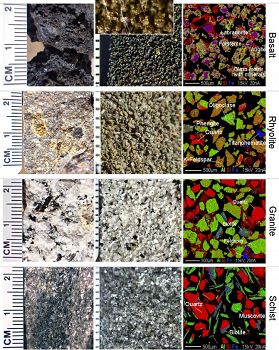Zaharescu et al., 2019
Ecosystem-bedrock interaction changes nutrient compartmentalization during early oxidative weathering
Zaharescu D.G., Burghelea C.I., Dontsova K., Presler J.K., Hunt E.A., Domanik K.J., Amistadi M.K., Sandhaus S., Munoz E.N., Gaddis E.E., Galey M., Vaquera-Ibarra M.O., Palacios-Menendez M.A., Castrejón-Martinez R., Roldán-Nicolau E.C., Li K., Maier R.M., Reinhard C.T., Chorover J. (2019)
Scientific Reports 9: 15006
-
Catalina-Jemez, INVESTIGATOR
Abstract
Physical and mineralogical differences among unreacted substrates. Physical features of the unprocessed (left) and processed (center, scale in mm) rocks used as experimental substrates. Right, electron microprobe X-ray reflectance images showing elemental distribution in the granular material. Inset in basalt (center) is a stereomicroscope image depicting 1 µm-thick mycorrhiza hyphae connecting plant roots (not imaged) to rock particles.
Ecosystem-bedrock interactions power the biogeochemical cycles of Earth’s shallow crust, supporting life, stimulating substrate transformation, and spurring evolutionary innovation. While oxidative processes have dominated half of terrestrial history, the relative contribution of the biosphere and its chemical fingerprints on Earth’s developing regolith are still poorly constrained. Here, we report results from a two-year incipient weathering experiment. We found that the mass release and compartmentalization of major elements during weathering of granite, rhyolite, schist and basalt was rock-specific and regulated by ecosystem components. A tight interplay between physiological needs of different biota, mineral dissolution rates, and substrate nutrient availability resulted in intricate elemental distribution patterns. Biota accelerated CO2 mineralization over abiotic controls as ecosystem complexity increased, and significantly modified the stoichiometry of mobilized elements. Microbial and fungal components inhibited element leaching (23.4% and 7%), while plants increased leaching and biomass retention by 63.4%. All biota left comparable biosignatures in the dissolved weathering products. Nevertheless, the magnitude and allocation of weathered fractions under abiotic and biotic treatments provide quantitative evidence for the role of major biosphere components in the evolution of upper continental crust, presenting critical information for large-scale biogeochemical models and for the search for stable in situ biosignatures beyond Earth.
Citation
Zaharescu D.G., Burghelea C.I., Dontsova K., Presler J.K., Hunt E.A., Domanik K.J., Amistadi M.K., Sandhaus S., Munoz E.N., Gaddis E.E., Galey M., Vaquera-Ibarra M.O., Palacios-Menendez M.A., Castrejón-Martinez R., Roldán-Nicolau E.C., Li K., Maier R.M., Reinhard C.T., Chorover J. (2019): Ecosystem-bedrock interaction changes nutrient compartmentalization during early oxidative weathering. Scientific Reports 9: 15006. DOI: 10.1038/s41598-019-51274-x
 This Paper/Book acknowledges NSF CZO grant support.
This Paper/Book acknowledges NSF CZO grant support.
Explore Further


